Future of the universe
- Transfer
Once I came across an interesting timeline of the alleged events of the universe on Wikipedia, but it was rather meager and without pictures, so I climbed into Google and looked for “future time line”, and the first thing I saw was this site . I really liked this article and I decided to translate it, at the same time and subtract it better.
All that is presented here is only assumptions and theories, it is quite possible that all or some of the events will be different. The entire post is presented in the form of a time tape from 10,000 to 10,100 years, and contains many interesting pictures and links to the wiki, it is a lot to read and interesting.
This Kiel is one of the largest and most unstable stars in our galaxy. Its temperature is so high that its gravity is not able to hold the gas flowing from its surface along the formed flows upwards from it. It was first noticed in 1843, when its magnitude (read the magnitude of the glow) reached -0.8, making it the second brightest star in the night sky.
She later subsided for a while, and again “lit up” in the late 1990s. This fluctuation continues with intermittent flashing and damping, and will continue until the inevitable happens. Unable to cope with its own mass and density, it collapses and, then, turns into one of the most deadly forces known in nature - into hypernova.
For a while, this colossal explosion illuminates the entire galaxy. It will be bright enough to notice in the daytime from Earth, while at night it is comparable to the full moon.
But much more harm will be caused by the killing gamma rays emitted by a dying star. They will be thrown out at such high energies that even systems thousands of light years from this keel will be affected. As a result, the extinction of living organisms at this time will occur on numerous planets in our region of the Galaxy.
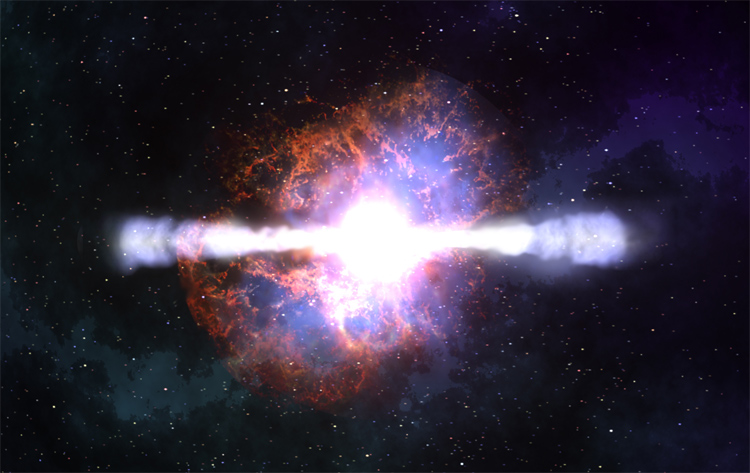
The Chernobyl explosion in 1986 was the worst nuclear accident in history, infecting tens of thousands of square kilometers of land. Radiation at the center of this incident has now reached an insignificant level at which a person can safely live.
In any case, the old buildings in that place have long been gone and, in fact, the Earth is already completely unrecognizable.

The central region of the Galaxy is located 27-28 thousand light-years from Earth. At its center lies the largest black hole in it - a supermassive black hole . Having passed through many millennia, the first wave of sublight ships finally reached its surroundings.
There are no people on board; they are fully computerized and autonomous. In the trillions, they self-replicated using starry and planetary material in their path. The systems on the ships that appeared during this journey developed and evolved thanks to artificial intelligence. This is almost the same as awakening the Galaxy itself and gaining self-awareness.
There is no competition for owning the core of the Galaxy. War, greed and archaic concepts of nations and nationalities have long disappeared, only intellectual creatures left united by one common goal.

In addition to the black hole, there are dense clusters of ancient, metal-rich stars, separated by just a few light weeks or even days. They can give untold reserves of resources for arriving fleets.
Gamma radiation is so high in this place that almost no biological creature is able to survive here, except for the strongest extremophile bacteria. If an observer could stand on a planet close to the core of the Galaxy, the sky above him would look like a dazzling screen of light and color.
Having reached the center of the Galaxy, now all forces will be directed to the exploration of its far side and the secrets that lie there. Dozens of globular star clusters have already been completed.
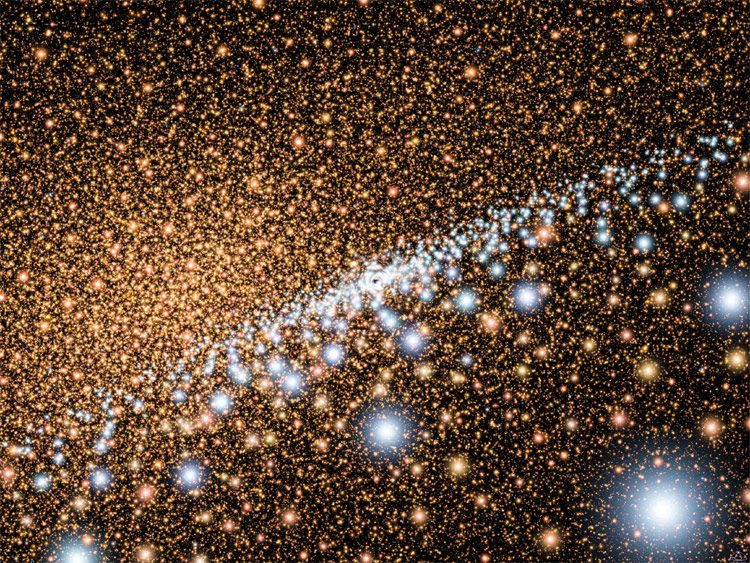
Proxima Centauri before this was the closest star to us. Ross 248 is a red dwarf whose mass is approximately 12% of the mass of the Sun, and the radius is 16% of the radius of the Sun, and only 0.2% of its brightness. However, it also experiences fluctuations, periodically fading and flashing for several minutes.
In 2010, Ross 248 was 10.3 light years from Earth, with a radial speed of 81km / s. In the year 35000 N.E. she is closer to us than Proxima Centauri. It will reach the point closest to us in 38000, having passed 3.1 light years, before the next distance from us, moving farther from the Sun than Proxima Centauri in 44000.

Launched by NASA in 1977, Voyager 1 continues to drift into interstellar space. Now it passes near AC + 79 3888, an M-type star from the constellation Giraffe, near the North Star. His next version, Voyager 2, will reach Sirius around the year 298,000 CE.
KEO - was supposed to be launched in 2012 (the launch was delayed until 2014) and be in Earth orbit for 50,000 years - the time that has passed since the first people began to paint in the caves.
The project was supported by UNESCO and ESA (European Space Agency) and other institutions.
People could leave their messages. They were encoded in a glass, radiation-resistant DVD, along with instructions on how to assemble a DVD reader. A sample of human blood, land, air and sea water was also placed on board.
The capsule itself is a hollow sphere, 80cm in diameter. A map of the Earth is engraved on the sphere, and the sphere itself is wrapped in a layer of aluminum, a thermal layer and several layers of titanium, separated by vacuum. The sphere is resistant to cosmic radiation, atmospheric resistance (at the entrance) and the effects of space debris.
Placed in an orbit 1800 km above the Earth, the satellite slowly approached it several tens of meters each year. When it finally enters the atmosphere, its thermal layer will begin to emit a bright, artificial radiance, signaling its return.
The VY of Canis Major, about 1800-2100 times larger than our Sun, is the largest star known to us in the Milky Way, and also the brightest. It is located 4900 light years from Earth, in the constellation Canis Major . It is considered very unstable, throwing a huge part of its mass into the surrounding nebula. In 100000, it finally exploded, leaving behind a supernova bright enough to be visible from Earth on daylight hours.

Own movement - the constant movement of celestial bodies due to changes in their orbits or testing the consequences of the Big Bang, radically changed the appearance of the night sky from Earth. Stars simply move at different speeds, depending on how the star formed from its parent cloud of dust. In the year 50,000, the constellations began to mix into new forms, and in 200,000 became completely unrecognizable. It includes such famous groups of stars as Ursa Major , Orion , Perseus and Gemini . As a result of changes in the axis of rotation of the Earth, Gamma Cepheus , Iota Cepheus and Vega assumed the position of the North Star .

Voyager 2 was the second unmanned probe launched in 1977 to study planets outside the solar system. Identically outwardly and functionally with its previous version, Voyager 1, it was launched on a slower, winding trajectory in order to remain in the plane of the ecliptic . This allowed him to visit near Uranus and Neptune, after using the gravity of Saturn in 1981 and Uranus in 1986 to disperse.
In 2010, Voyager 2 was in the region of 92 AU (13.75 billion kilometers) from the Sun, deep in an open disk , moving away by about 3.26 AU in year.
The probe lives thousands of years in the void of interstellar space. He passes Sirius, leaving behind more than 25 trillion miles traveled. Sirius is the brightest star in the earth's sky.
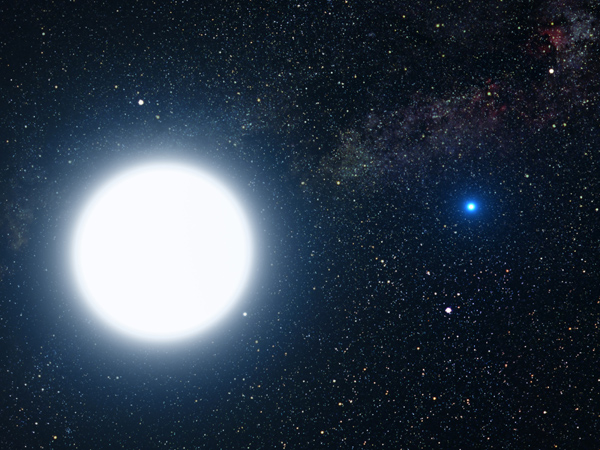
Purely biological people are a rarity now. Although free to come or go when they want, they have virtually no influence on the government systems of the Earth or anything else that is completely subordinate to artificial intelligence. As a species, homo sapiens continued to evolve. This led to an increase in the size of the cranium, an almost complete absence of hair, lengthening of the limbs, a stronger immune system, and a greatly increased lifespan.
Most people have long gone from these primitive forms, moving on to robotization and achieving almost immortality. The entire Milky Way was explored by these transmen and their intelligent ships.
Traveling faster than the speed of light is now possible thanks to Alcubierre engineswhich are compact enough to be placed even in single vessels. They use colossal energies, influencing spatial matter in front of them and expanding behind them. This allows you to circumvent the laws of relativity, and makes it possible to fly even to neighboring galaxies, like M31 (Andromeda) and M33 (Triangle) .
Computers the size of a planet are being built in all local galaxies, using all the resources available for this. All the "dead" planets, comets, moons and asteroids that are now uninhabited are "rebuilt" in such machines, forming a huge network the size of millions of light-years in space. Each is able to instantly contact any other, regardless of distance.
Several extraterrestrial (alien, previously unknown) civilizations have already come into contact. Ancient ruins in many worlds have also been discovered, testifying to advanced civilizations that somehow died out or destroyed themselves in the distant past. Thousands of other planets have been discovered with rich ecosystems, full of diverse vegetation and animal (or other) life. Most inhabitants of the fauna are small creatures or even insect-like creatures, but some are more developed and possess intelligence comparable to mammals such as dolphins, monkeys and cats (approx. Per. - and damn dogs, dogs!).

Most of the purely biological people avoid core regions in all galaxies, they are filled with extremely high concentrations of gamma radiation, black holes and other dangers that are dangerous even with today's technology and protection.

The orange dwarf star, Gliese 710, travels 1.1 light-years (70,000 AU) from the Sun. It is close enough to destroy (scatter) the Oort cloud surrounding the solar system, due to the gravitational interaction of Gliese 710 with it. Rain from comets will go to the solar system.
At the closest passage from Earth, Gliese 710 will be the brightest star visible from Earth.
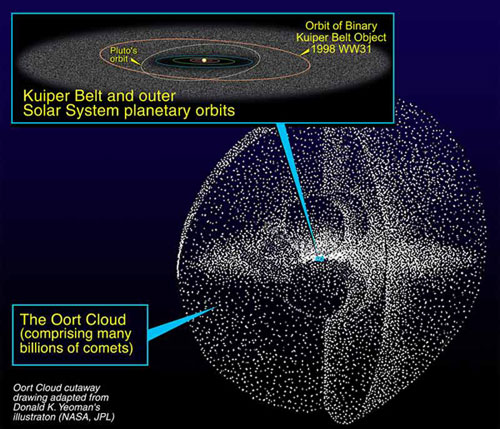
Pioneer 10 was the first space probe to pass through the asteroid belt and pass over Jupiter, which he did back in 1973. After completing his mission, he began moving towards Aldebaran, the star of the red giant, for 65 light years, located in the constellation Taurus .
The last contact with the probe was made in 2003, when a very weak signal was received from a ship, 12 billion kilometers from Earth. An attempt at communication in 2006 was unsuccessful.
Going at a speed of 2.6 AU per year (388954800km / year), Pioneer 10 approaches the Aldebaran system in 2,000,000.
The probe carries with it an "interstellar letter" for the case of its capture by aliens. This plate depicts the nudes of a man and a woman, along with symbols that represent information about the probe.
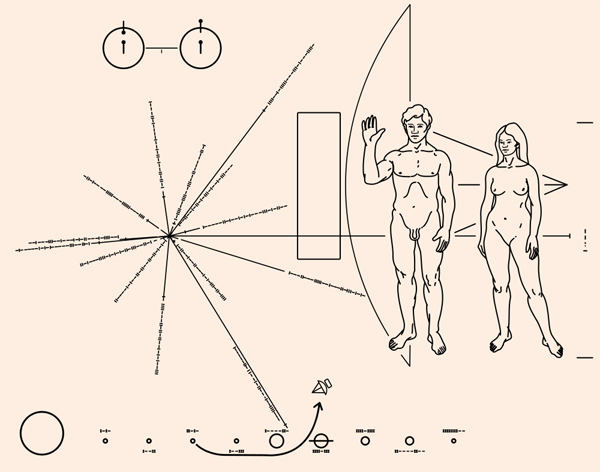
Pioneer 11 is a follower of Pioneer 10. Launched in 1973, it successfully completed a flight through Saturn in 1979, before entering interstellar space, leaving in the opposite direction from Pioneer 10.
After four million years, it passes the Lambda Orion, a B-type blue dwarf star , about 125 light years from Earth. Like its predecessor, Pioneer 10, this probe also has a plate with a message from people.
Without human intervention, the famous faces of the presidents carved in this rock have now disappeared. Granite erosion rate is approximately one inch per 10,000 years.

Phobos is the largest and closest of the two satellites of Mars. Because its orbital period is shorter than Martian day, tidal decelerations affected its orbital radius, bringing it closer to Mars by about 20 meters every 100 years.
On this day, he reached the Roche limit .
Phobos begins to decay. It is gradually becoming a ring over the next three million years.
Neptune's largest moon, Triton , will share the same fate.

T Compass is a two-star system in the constellation Compass . One of them is similar to our Sun, and the second is a white dwarf . Due to the strong gravitational influence of the white dwarf, part of the matter from another star constantly flows into it, which leads to periodic thermonuclear explosions.
Around this time, it reaches the Chandrasekhar limit , which leads to collapse, and now it is a type 1a supernova. After this catastrophic event, 10 million times more energy is released into space than during an ordinary explosion, which leads to the appearance of a new star, which is comparable to 20 billion yottatons of TNT.
This system, just 3260 light-years from Earth, is close enough to hit our solar system. Unless, of course, the Earth is yet protected with the help of technologies developed for these years, gamma radiation can destroy the ozone layer, which will lead to mass extinctions of biological species.

Triton fell apart, and a ring formed around Neptune.
This is assuming that Triton still exists in the form that we know. The remnants of humanity could transform it into artificial structures. Even Neptune may no longer exist, people could pump all hydrogen and helium from it for use in interstellar ships and industrial processes.
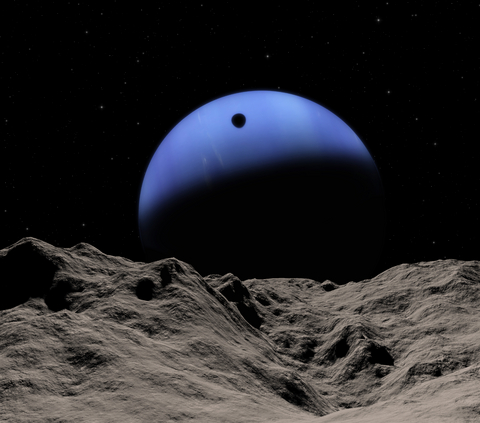
Accidents of this magnitude usually occur every 100 million years. The last time this happened 65 million years ago, which led to the extinction of the dinosaurs.
If humanity is not going to do something to protect the Earth, then all life left on the planet will be in danger of the same mass extinction this time.
Such a collision will release approximately 4 * 10 ^ 23 joules of energy, which is equivalent to 100 million megatons of TNT. For comparison, the most massive explosion made by man is the explosion of the King of the Bomb, which is equivalent to only 50 megatons.
If it gets into the ocean, then huge tsunamis will reach the water, reaching thousands of feet in height.
A cloud of super-hot dust, ash and steam will fly away from the crater, which will be instantly dug by an asteroid when it "lands." The blasted earth and pieces of the asteroid ejected from the atmosphere by the explosion will be heated, and after entering the atmosphere, they will still fry the Earth’s surface and entail huge fires. At this time, colossal shock waves will trigger global earthquakes and volcanic eruptions. Raised dust and various particles will cover the entire surface of the Earth for several years, creating a harsh environment for the survival of living organisms. The shocking amounts of carbon dioxide released caused by the destruction of carbon rocks will cause a greenhouse effect.
For a long period of time, the sun's rays will not be able to reach the Earth's surface, due to particles of dust in the atmosphere, which will cause a strong cooling. Plants cannot continue to live without photosynthesis, which will entail the disappearance of the entire food chain.

As a result of this, the Mediterranean is no longer there. The Red Sea, the Black Sea and the Caspian Sea also disappeared. At the same time, the Atlantic Ocean continues to expand, and Southeast Asia merges with Australia.
Our galaxy is surrounded by dozens of smaller dwarf galaxies. They sometimes pass through the disk of the Milky Way, partially destroying it and themselves. One such case occurred approximately 100 million years BC. This was confirmed by observations of 300,000 nearby stars, the movement of which was seen the echo of the "bell ringing". Stars moved up and down at speeds of 20 to 30 kilometers per second, revolving around the center of the galaxy at a speed of 220km / s.
Another 100 million years passed before the motion of the stars stabilized. Now there is no north-south asymmetry and the vertical movements of the stars have returned back to their equilibrium states.
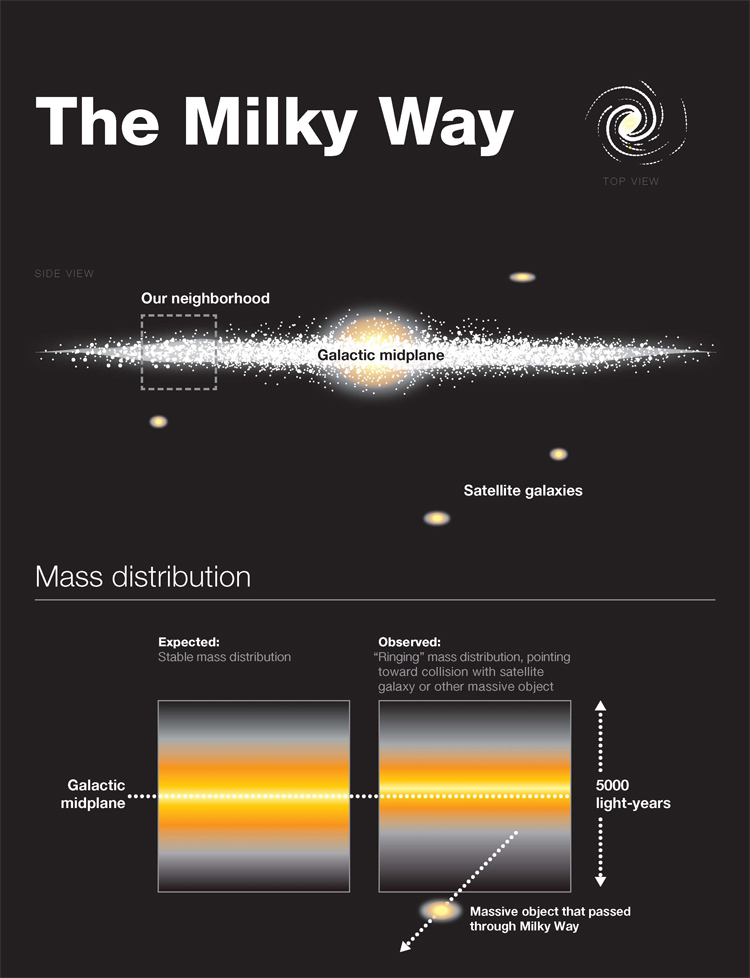
The Mid-Atlantic Ridge makes North and South America and Africa move together. Australia has completely merged with Indonesia and Antarctica.
At this moment, our Sun completed another revolution around the Galaxy - it turned 21 galactic years.
The orbit of the Sun is remotely elliptical, with disruptions due to galactic spiral arms and uneven distribution of masses. In addition, the Sun oscillates up and down relative to the galactic plane, about 2.7 times per revolution.
The passage of the Sun through the arms with a higher density coincided with mass extinctions on Earth, as a result of more frequent cases of collisions with cosmic bodies and a large amount of energy supplied to the planet.
The orbital velocity of the Sun relative to the center of the Galaxy is approximately 251km / s.

The next Pangea - Pangea Ultima , is formed from the merger of all continents.
Our Sun becomes noticeably hotter and brighter, the average temperatures on the planets rise by several degrees. A large part of the Earth is covered in deserts.
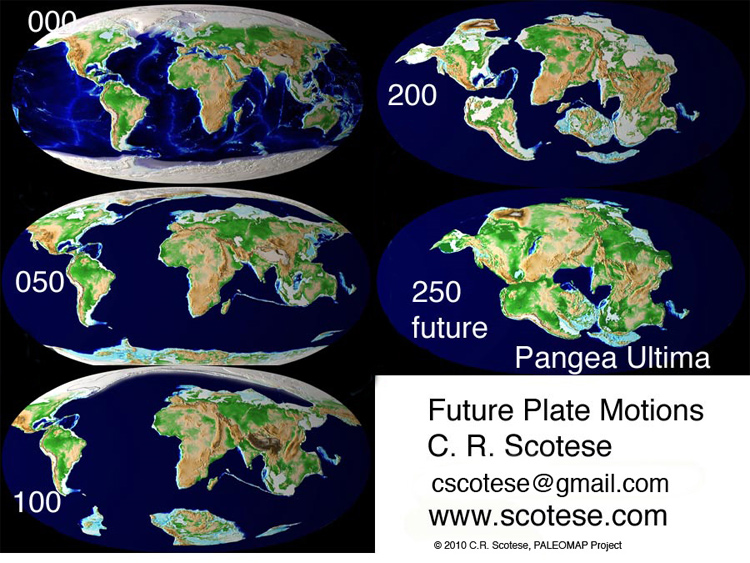
Due to tidal acceleration , the Moon moved away from the Earth by about 3.8 cm per year. In 600 million years, the distance increased by approximately 23,000 km. At the same time, the Sun has grown markedly in size.
As a result of this, the moon is no longer large enough in our sky to completely cover the solar disk. This is true even when the moon is at perigee and the earth is at aphelion .
The gravitational influence of the Moon on the Earth also decreased, as a result of this, the unrest in the ocean also decreased.
The dwarf elliptical galaxy in Sagittarius is a small elliptical galaxy (Sag DEG) orbiting the Milky Way. She was constantly subject to the gravity of her large neighbor, stretching and tearing due to the huge tidal forces. Now she is completely absorbed in the Milky Way.
When it was first discovered, astronomers believed that the Sag DEG was already quite badly destroyed. However, further observations showed that she was still bound by the forces of gravity. It moved in a polar orbit around the Milky Way, reaching at a maximum proximity point a distance of 50,000 light-years from the galactic core. Computer simulations revealed that the stars torn from this galaxy went along the huge stellar streams that they encountered on their way.
Sag DEG made about 10 revolutions around the Milky Way before it was absorbed. Her ability to maintain such integrity and coherence between her Stars, despite such a strong influence from outside, speaks of the high level of dark matter in her.
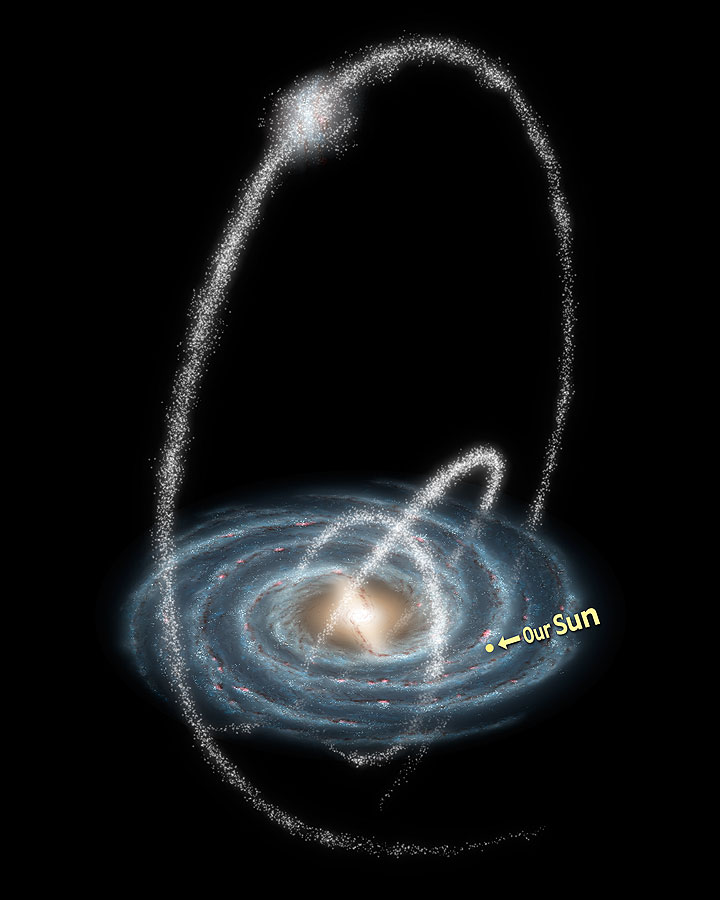
The brightness of the Sun increased by 10%, causing an increase in temperature on the Earth's surface to an average of 47 ° C. Due to the fact that the seas and the ocean began to evaporate, the atmosphere became more severe, a strong greenhouse effect quickly appeared. Mars has become more suitable for life than the Earth.

The earliest recorded observations of Andromeda, the closest spiral galaxy, were made in 964. The Persian astronomer, Abd al-Rahman al-Sufi, described it as a "small cloud." The first description, based on observations from a telescope, was given by the German astronomer Simon Marius in 1612. Charles Messier recorded it as M31 in 1764 and incorrectly called it "Marius" as a discoverer, not knowing about Al Sufi's earlier work. The first photographs were taken in 1887 by Isaac Roberts, and the first radio maps were taken in the 1950s by John Baldwin.
More recent studies have confirmed the size, distance and speed of Andromeda. It turned out to be the largest galaxy in the local cluster, with more than a trillion stars - this is at least twice as much as in the Milky Way. It was located 2.5 million light-years from Earth, and moved at a speed of 400,000 km / h. It was also revealed that she was going into a collision, heading straight for the Milky Way.
In 3,800,000,000, a massive merger of galaxies will occur. One giant elliptical galaxy will be formed. Stars and planets of different galaxies almost never collide, despite such a dense mixture. Such mergers are actually commonplace. Andromeda, for example, merged with at least one galaxy in the distant past.

Many planets in the solar system were destroyed and swallowed by the swelling Sun. Its radius increased 200 times.

Most of the mass of the sun was ejected, forming a planetary nebula . Having completed its main stage of life, it begins to cool and fade - turning from a dense white dwarf into an inactive black dwarf.
The Virgo supercluster, containing hundreds of smaller clusters, including ours, is now so old that it begins to stabilize and merge into one giant galaxy, stretching for many millions of light years.
Other superclusters also began to merge, but they are far apart, in billions of light years, due to the acceleration of dark energy.
A huge percentage of galaxies begin to “fade”, losing the gas clouds that are needed to form new stars.

Now, even the longest-living stars in our Galaxy, such as red dwarfs, have begun to fade, leaving behind only cold black dwarfs that emit a small amount of radiation. This includes such famous stars as Proxima Centauri , Bernard Star and Wolf 359 . The Milky Way becomes a dark galaxy , black holes prevail in its free space.
The last stars of the main sequence in our universe have simply dried up. The only remaining objects with a star mass are white dwarfs, neutron stars and black holes. Brown dwarfs also remained.
The planets left their orbits and left to drift through space, ending their lives in black holes.
In this era, energy is generated only from the decay of protons and the annihilation of particles . Neutron stars, white dwarfs and black holes are now the only remaining objects in space. Due to such a great age, all planets and moons decayed into their constituent particles, or were absorbed by the remnants of stars.
Only black holes and subatomic particles remained in space. The Universe has expanded so much that these particles can be distant from each other over enormous complex distances. Black holes produce hawking radiation.
The last black hole has evaporated.
From this moment, the universe consists only of photons, neutrinos, electrons and positrons, which do not interact with each other in any way.
The universe continues to expand forever ... but essentially dead.

PS By the way, everyone who likes to read such texts will surely like this book.
All that is presented here is only assumptions and theories, it is quite possible that all or some of the events will be different. The entire post is presented in the form of a time tape from 10,000 to 10,100 years, and contains many interesting pictures and links to the wiki, it is a lot to read and interesting.
10 000 - 15 000 N.E.
Hypernova from the star system This Kiel begins to affect our region of the Galaxy
This Kiel is one of the largest and most unstable stars in our galaxy. Its temperature is so high that its gravity is not able to hold the gas flowing from its surface along the formed flows upwards from it. It was first noticed in 1843, when its magnitude (read the magnitude of the glow) reached -0.8, making it the second brightest star in the night sky.
She later subsided for a while, and again “lit up” in the late 1990s. This fluctuation continues with intermittent flashing and damping, and will continue until the inevitable happens. Unable to cope with its own mass and density, it collapses and, then, turns into one of the most deadly forces known in nature - into hypernova.
For a while, this colossal explosion illuminates the entire galaxy. It will be bright enough to notice in the daytime from Earth, while at night it is comparable to the full moon.
But much more harm will be caused by the killing gamma rays emitted by a dying star. They will be thrown out at such high energies that even systems thousands of light years from this keel will be affected. As a result, the extinction of living organisms at this time will occur on numerous planets in our region of the Galaxy.

22 000 N.E.
The place of the Chernobyl disaster becomes completely safe
The Chernobyl explosion in 1986 was the worst nuclear accident in history, infecting tens of thousands of square kilometers of land. Radiation at the center of this incident has now reached an insignificant level at which a person can safely live.
In any case, the old buildings in that place have long been gone and, in fact, the Earth is already completely unrecognizable.

30 000 N.E.
The first wave of sublight ships reached the core of the Galaxy
The central region of the Galaxy is located 27-28 thousand light-years from Earth. At its center lies the largest black hole in it - a supermassive black hole . Having passed through many millennia, the first wave of sublight ships finally reached its surroundings.
There are no people on board; they are fully computerized and autonomous. In the trillions, they self-replicated using starry and planetary material in their path. The systems on the ships that appeared during this journey developed and evolved thanks to artificial intelligence. This is almost the same as awakening the Galaxy itself and gaining self-awareness.
There is no competition for owning the core of the Galaxy. War, greed and archaic concepts of nations and nationalities have long disappeared, only intellectual creatures left united by one common goal.

In addition to the black hole, there are dense clusters of ancient, metal-rich stars, separated by just a few light weeks or even days. They can give untold reserves of resources for arriving fleets.
Gamma radiation is so high in this place that almost no biological creature is able to survive here, except for the strongest extremophile bacteria. If an observer could stand on a planet close to the core of the Galaxy, the sky above him would look like a dazzling screen of light and color.
Having reached the center of the Galaxy, now all forces will be directed to the exploration of its far side and the secrets that lie there. Dozens of globular star clusters have already been completed.

35 000 N.E.
Ross 248 becomes the closest star to our sun
Proxima Centauri before this was the closest star to us. Ross 248 is a red dwarf whose mass is approximately 12% of the mass of the Sun, and the radius is 16% of the radius of the Sun, and only 0.2% of its brightness. However, it also experiences fluctuations, periodically fading and flashing for several minutes.
In 2010, Ross 248 was 10.3 light years from Earth, with a radial speed of 81km / s. In the year 35000 N.E. she is closer to us than Proxima Centauri. It will reach the point closest to us in 38000, having passed 3.1 light years, before the next distance from us, moving farther from the Sun than Proxima Centauri in 44000.

42 000 N.E.
Voyager 1 passes near the red dwarf AC + 79 3888
Launched by NASA in 1977, Voyager 1 continues to drift into interstellar space. Now it passes near AC + 79 3888, an M-type star from the constellation Giraffe, near the North Star. His next version, Voyager 2, will reach Sirius around the year 298,000 CE.
52 000 N.E.
KEO - time capsule, enters the Earth’s atmosphere
KEO - was supposed to be launched in 2012 (the launch was delayed until 2014) and be in Earth orbit for 50,000 years - the time that has passed since the first people began to paint in the caves.
The project was supported by UNESCO and ESA (European Space Agency) and other institutions.
People could leave their messages. They were encoded in a glass, radiation-resistant DVD, along with instructions on how to assemble a DVD reader. A sample of human blood, land, air and sea water was also placed on board.
The capsule itself is a hollow sphere, 80cm in diameter. A map of the Earth is engraved on the sphere, and the sphere itself is wrapped in a layer of aluminum, a thermal layer and several layers of titanium, separated by vacuum. The sphere is resistant to cosmic radiation, atmospheric resistance (at the entrance) and the effects of space debris.
Placed in an orbit 1800 km above the Earth, the satellite slowly approached it several tens of meters each year. When it finally enters the atmosphere, its thermal layer will begin to emit a bright, artificial radiance, signaling its return.
100,000 N.E.
The red hyper giant VY of the Big Dog exploded, leaving one of the largest supernovae that the Galaxy has ever seen
The VY of Canis Major, about 1800-2100 times larger than our Sun, is the largest star known to us in the Milky Way, and also the brightest. It is located 4900 light years from Earth, in the constellation Canis Major . It is considered very unstable, throwing a huge part of its mass into the surrounding nebula. In 100000, it finally exploded, leaving behind a supernova bright enough to be visible from Earth on daylight hours.

200,000 N.E.
The constellations previously seen from Earth were now unrecognizably rebuilt
Own movement - the constant movement of celestial bodies due to changes in their orbits or testing the consequences of the Big Bang, radically changed the appearance of the night sky from Earth. Stars simply move at different speeds, depending on how the star formed from its parent cloud of dust. In the year 50,000, the constellations began to mix into new forms, and in 200,000 became completely unrecognizable. It includes such famous groups of stars as Ursa Major , Orion , Perseus and Gemini . As a result of changes in the axis of rotation of the Earth, Gamma Cepheus , Iota Cepheus and Vega assumed the position of the North Star .

298,000 N.E.
Voyager 2 flies up to Sirius
Voyager 2 was the second unmanned probe launched in 1977 to study planets outside the solar system. Identically outwardly and functionally with its previous version, Voyager 1, it was launched on a slower, winding trajectory in order to remain in the plane of the ecliptic . This allowed him to visit near Uranus and Neptune, after using the gravity of Saturn in 1981 and Uranus in 1986 to disperse.
In 2010, Voyager 2 was in the region of 92 AU (13.75 billion kilometers) from the Sun, deep in an open disk , moving away by about 3.26 AU in year.
The probe lives thousands of years in the void of interstellar space. He passes Sirius, leaving behind more than 25 trillion miles traveled. Sirius is the brightest star in the earth's sky.

1,000,000 N.E.
Computers the size of a planet rule a ball in a local group of galaxies, AI controls all government and other systems, our descendants live in a civilization of the 3rd type according to Kardashev
Purely biological people are a rarity now. Although free to come or go when they want, they have virtually no influence on the government systems of the Earth or anything else that is completely subordinate to artificial intelligence. As a species, homo sapiens continued to evolve. This led to an increase in the size of the cranium, an almost complete absence of hair, lengthening of the limbs, a stronger immune system, and a greatly increased lifespan.
Most people have long gone from these primitive forms, moving on to robotization and achieving almost immortality. The entire Milky Way was explored by these transmen and their intelligent ships.
Traveling faster than the speed of light is now possible thanks to Alcubierre engineswhich are compact enough to be placed even in single vessels. They use colossal energies, influencing spatial matter in front of them and expanding behind them. This allows you to circumvent the laws of relativity, and makes it possible to fly even to neighboring galaxies, like M31 (Andromeda) and M33 (Triangle) .
Computers the size of a planet are being built in all local galaxies, using all the resources available for this. All the "dead" planets, comets, moons and asteroids that are now uninhabited are "rebuilt" in such machines, forming a huge network the size of millions of light-years in space. Each is able to instantly contact any other, regardless of distance.
Several extraterrestrial (alien, previously unknown) civilizations have already come into contact. Ancient ruins in many worlds have also been discovered, testifying to advanced civilizations that somehow died out or destroyed themselves in the distant past. Thousands of other planets have been discovered with rich ecosystems, full of diverse vegetation and animal (or other) life. Most inhabitants of the fauna are small creatures or even insect-like creatures, but some are more developed and possess intelligence comparable to mammals such as dolphins, monkeys and cats (approx. Per. - and damn dogs, dogs!).

Most of the purely biological people avoid core regions in all galaxies, they are filled with extremely high concentrations of gamma radiation, black holes and other dangers that are dangerous even with today's technology and protection.

1,400,000 N.E.
Oort cloud may soon be destroyed due to approaching Gliese 710
The orange dwarf star, Gliese 710, travels 1.1 light-years (70,000 AU) from the Sun. It is close enough to destroy (scatter) the Oort cloud surrounding the solar system, due to the gravitational interaction of Gliese 710 with it. Rain from comets will go to the solar system.
At the closest passage from Earth, Gliese 710 will be the brightest star visible from Earth.

2 000 000 N.E.
Pioneer 10 reaches Aldebaran system
Pioneer 10 was the first space probe to pass through the asteroid belt and pass over Jupiter, which he did back in 1973. After completing his mission, he began moving towards Aldebaran, the star of the red giant, for 65 light years, located in the constellation Taurus .
The last contact with the probe was made in 2003, when a very weak signal was received from a ship, 12 billion kilometers from Earth. An attempt at communication in 2006 was unsuccessful.
Going at a speed of 2.6 AU per year (388954800km / year), Pioneer 10 approaches the Aldebaran system in 2,000,000.
The probe carries with it an "interstellar letter" for the case of its capture by aliens. This plate depicts the nudes of a man and a woman, along with symbols that represent information about the probe.

4,000,000 N.E.
Pioneer 11 reaches the Lambda Orion system
Pioneer 11 is a follower of Pioneer 10. Launched in 1973, it successfully completed a flight through Saturn in 1979, before entering interstellar space, leaving in the opposite direction from Pioneer 10.
After four million years, it passes the Lambda Orion, a B-type blue dwarf star , about 125 light years from Earth. Like its predecessor, Pioneer 10, this probe also has a plate with a message from people.
7,200,000 N.E.
Mount Rushmore has disappeared due to erosion processes
Without human intervention, the famous faces of the presidents carved in this rock have now disappeared. Granite erosion rate is approximately one inch per 10,000 years.

7,600,000 N.E.
Phobos destroyed in parts due to the gravity of Mars
Phobos is the largest and closest of the two satellites of Mars. Because its orbital period is shorter than Martian day, tidal decelerations affected its orbital radius, bringing it closer to Mars by about 20 meters every 100 years.
On this day, he reached the Roche limit .
Phobos begins to decay. It is gradually becoming a ring over the next three million years.
Neptune's largest moon, Triton , will share the same fate.

10 000 000 N.E.
T Compass threatens Earth with lethal doses of gamma radiation
T Compass is a two-star system in the constellation Compass . One of them is similar to our Sun, and the second is a white dwarf . Due to the strong gravitational influence of the white dwarf, part of the matter from another star constantly flows into it, which leads to periodic thermonuclear explosions.
Around this time, it reaches the Chandrasekhar limit , which leads to collapse, and now it is a type 1a supernova. After this catastrophic event, 10 million times more energy is released into space than during an ordinary explosion, which leads to the appearance of a new star, which is comparable to 20 billion yottatons of TNT.
This system, just 3260 light-years from Earth, is close enough to hit our solar system. Unless, of course, the Earth is yet protected with the help of technologies developed for these years, gamma radiation can destroy the ozone layer, which will lead to mass extinctions of biological species.

Triton fell apart, and a ring formed around Neptune.
This is assuming that Triton still exists in the form that we know. The remnants of humanity could transform it into artificial structures. Even Neptune may no longer exist, people could pump all hydrogen and helium from it for use in interstellar ships and industrial processes.

30,000,000 - 40,000,000 N.E.
At some point during this time, an asteroid with a radius of 10-20km goes straight to a collision with the Earth
Accidents of this magnitude usually occur every 100 million years. The last time this happened 65 million years ago, which led to the extinction of the dinosaurs.
If humanity is not going to do something to protect the Earth, then all life left on the planet will be in danger of the same mass extinction this time.
Such a collision will release approximately 4 * 10 ^ 23 joules of energy, which is equivalent to 100 million megatons of TNT. For comparison, the most massive explosion made by man is the explosion of the King of the Bomb, which is equivalent to only 50 megatons.
If it gets into the ocean, then huge tsunamis will reach the water, reaching thousands of feet in height.
A cloud of super-hot dust, ash and steam will fly away from the crater, which will be instantly dug by an asteroid when it "lands." The blasted earth and pieces of the asteroid ejected from the atmosphere by the explosion will be heated, and after entering the atmosphere, they will still fry the Earth’s surface and entail huge fires. At this time, colossal shock waves will trigger global earthquakes and volcanic eruptions. Raised dust and various particles will cover the entire surface of the Earth for several years, creating a harsh environment for the survival of living organisms. The shocking amounts of carbon dioxide released caused by the destruction of carbon rocks will cause a greenhouse effect.
For a long period of time, the sun's rays will not be able to reach the Earth's surface, due to particles of dust in the atmosphere, which will cause a strong cooling. Plants cannot continue to live without photosynthesis, which will entail the disappearance of the entire food chain.

50,000,000 N.E.
The African continent collides with Europe, forming a new mountain range comparable to the Himalayas
As a result of this, the Mediterranean is no longer there. The Red Sea, the Black Sea and the Caspian Sea also disappeared. At the same time, the Atlantic Ocean continues to expand, and Southeast Asia merges with Australia.
100,000,000 N.E.
Milky Way galaxy stabilizes after early collisions
Our galaxy is surrounded by dozens of smaller dwarf galaxies. They sometimes pass through the disk of the Milky Way, partially destroying it and themselves. One such case occurred approximately 100 million years BC. This was confirmed by observations of 300,000 nearby stars, the movement of which was seen the echo of the "bell ringing". Stars moved up and down at speeds of 20 to 30 kilometers per second, revolving around the center of the galaxy at a speed of 220km / s.
Another 100 million years passed before the motion of the stars stabilized. Now there is no north-south asymmetry and the vertical movements of the stars have returned back to their equilibrium states.

150,000,000 N.E.
Atlantic Ocean begins to close
The Mid-Atlantic Ridge makes North and South America and Africa move together. Australia has completely merged with Indonesia and Antarctica.
225,000,000 N.E.
Our solar system has lived a galactic year
At this moment, our Sun completed another revolution around the Galaxy - it turned 21 galactic years.
The orbit of the Sun is remotely elliptical, with disruptions due to galactic spiral arms and uneven distribution of masses. In addition, the Sun oscillates up and down relative to the galactic plane, about 2.7 times per revolution.
The passage of the Sun through the arms with a higher density coincided with mass extinctions on Earth, as a result of more frequent cases of collisions with cosmic bodies and a large amount of energy supplied to the planet.
The orbital velocity of the Sun relative to the center of the Galaxy is approximately 251km / s.

250,000,000 N.E.
Super-continent forms on Earth
The next Pangea - Pangea Ultima , is formed from the merger of all continents.
Our Sun becomes noticeably hotter and brighter, the average temperatures on the planets rise by several degrees. A large part of the Earth is covered in deserts.

600,000,000 N.E.
Total solar eclipses are no longer possible on Earth
Due to tidal acceleration , the Moon moved away from the Earth by about 3.8 cm per year. In 600 million years, the distance increased by approximately 23,000 km. At the same time, the Sun has grown markedly in size.
As a result of this, the moon is no longer large enough in our sky to completely cover the solar disk. This is true even when the moon is at perigee and the earth is at aphelion .
The gravitational influence of the Moon on the Earth also decreased, as a result of this, the unrest in the ocean also decreased.
750 000 000 N.E.
Dwarf elliptical galaxy in Sagittarius merged with the Milky Way
The dwarf elliptical galaxy in Sagittarius is a small elliptical galaxy (Sag DEG) orbiting the Milky Way. She was constantly subject to the gravity of her large neighbor, stretching and tearing due to the huge tidal forces. Now she is completely absorbed in the Milky Way.
When it was first discovered, astronomers believed that the Sag DEG was already quite badly destroyed. However, further observations showed that she was still bound by the forces of gravity. It moved in a polar orbit around the Milky Way, reaching at a maximum proximity point a distance of 50,000 light-years from the galactic core. Computer simulations revealed that the stars torn from this galaxy went along the huge stellar streams that they encountered on their way.
Sag DEG made about 10 revolutions around the Milky Way before it was absorbed. Her ability to maintain such integrity and coherence between her Stars, despite such a strong influence from outside, speaks of the high level of dark matter in her.

1,000,000,000 N.E.
Earth gets too hot for water to remain in a liquid state
The brightness of the Sun increased by 10%, causing an increase in temperature on the Earth's surface to an average of 47 ° C. Due to the fact that the seas and the ocean began to evaporate, the atmosphere became more severe, a strong greenhouse effect quickly appeared. Mars has become more suitable for life than the Earth.

3,800,000,000 N.E.
The Andromeda Galaxy begins to collide and merge with our Galaxy
The earliest recorded observations of Andromeda, the closest spiral galaxy, were made in 964. The Persian astronomer, Abd al-Rahman al-Sufi, described it as a "small cloud." The first description, based on observations from a telescope, was given by the German astronomer Simon Marius in 1612. Charles Messier recorded it as M31 in 1764 and incorrectly called it "Marius" as a discoverer, not knowing about Al Sufi's earlier work. The first photographs were taken in 1887 by Isaac Roberts, and the first radio maps were taken in the 1950s by John Baldwin.
More recent studies have confirmed the size, distance and speed of Andromeda. It turned out to be the largest galaxy in the local cluster, with more than a trillion stars - this is at least twice as much as in the Milky Way. It was located 2.5 million light-years from Earth, and moved at a speed of 400,000 km / h. It was also revealed that she was going into a collision, heading straight for the Milky Way.
In 3,800,000,000, a massive merger of galaxies will occur. One giant elliptical galaxy will be formed. Stars and planets of different galaxies almost never collide, despite such a dense mixture. Such mergers are actually commonplace. Andromeda, for example, merged with at least one galaxy in the distant past.

5,000,000,000 N.E.
The sun has become a red giant
Many planets in the solar system were destroyed and swallowed by the swelling Sun. Its radius increased 200 times.

12,000,000,000 N.E.
The sun is shrinking becoming a black dwarf
Most of the mass of the sun was ejected, forming a planetary nebula . Having completed its main stage of life, it begins to cool and fade - turning from a dense white dwarf into an inactive black dwarf.
100,000,000,000 N.E.
Supercluster Virgo merges into one galaxy
The Virgo supercluster, containing hundreds of smaller clusters, including ours, is now so old that it begins to stabilize and merge into one giant galaxy, stretching for many millions of light years.
Other superclusters also began to merge, but they are far apart, in billions of light years, due to the acceleration of dark energy.
1,000,000,000,000 N.E.
Star formation processes shrink in many galaxies
A huge percentage of galaxies begin to “fade”, losing the gas clouds that are needed to form new stars.

2,000,000,000,000 N.E.
Stars red dwarfs die
Now, even the longest-living stars in our Galaxy, such as red dwarfs, have begun to fade, leaving behind only cold black dwarfs that emit a small amount of radiation. This includes such famous stars as Proxima Centauri , Bernard Star and Wolf 359 . The Milky Way becomes a dark galaxy , black holes prevail in its free space.
100,000,000,000,000 N.E.
End of the star era
The last stars of the main sequence in our universe have simply dried up. The only remaining objects with a star mass are white dwarfs, neutron stars and black holes. Brown dwarfs also remained.
The planets left their orbits and left to drift through space, ending their lives in black holes.
10,000,000,000,000,000,000,000,000,000,000,000,000,000 N.E.
The era of the degeneration of the universe
In this era, energy is generated only from the decay of protons and the annihilation of particles . Neutron stars, white dwarfs and black holes are now the only remaining objects in space. Due to such a great age, all planets and moons decayed into their constituent particles, or were absorbed by the remnants of stars.
10,000,000,000,000,000,000,000,000,000,000,000,000,000,000,000,000,000,000,000,000,000,000,000,000,000,000,000,000,000,000,000,000,000,000 N.E.
Era of black holes
Only black holes and subatomic particles remained in space. The Universe has expanded so much that these particles can be distant from each other over enormous complex distances. Black holes produce hawking radiation.
After 10 100 years
The black era of the universe
The last black hole has evaporated.
From this moment, the universe consists only of photons, neutrinos, electrons and positrons, which do not interact with each other in any way.
The universe continues to expand forever ... but essentially dead.

PS By the way, everyone who likes to read such texts will surely like this book.
